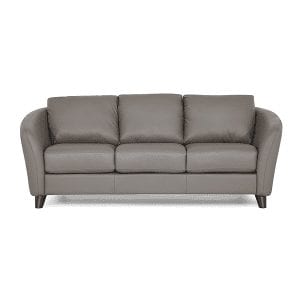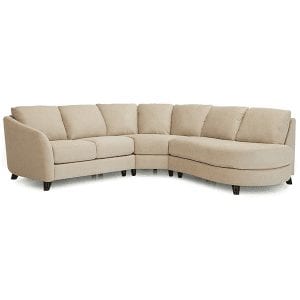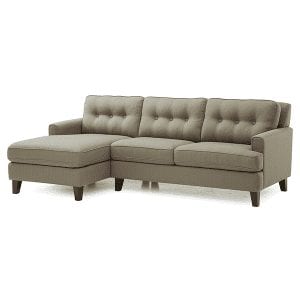Curved furniture has become one of today’s most popular design trends. It offers a perfect mix of comfort, style and function.
Unlike straight-lined pieces, curved furniture design brings soft, flowing shapes to your home. These organic forms can turn any room into a stylish, welcoming space.
Modern curved furniture offers more than just good looks. These pieces provide unique benefits that straight furniture cannot match. They improve comfort and help create better traffic flow in your home.
Ready to explore curved furniture options?
Visit Lifestyles Furniture in Columbia, MO, where our expert team can help you find the perfect curved pieces for your home.
Key Benefits of Curved Furniture
Better Comfort and Body Support
- Ergonomic furniture – Curved sofas naturally follow your body’s shape. This provides better support than square furniture with sharp edges.
- Alleviates physical stressors – A curved sofa eliminates pressure points that can cause discomfort. The gentle curves make these pieces perfect for long periods of sitting or entertaining guests.
- Enhances social gatherings – Curved tables also improve social interaction. Round dining tables let everyone see and talk to each other more easily than rectangular ones.
Smart Space Use and Better Flow
One of the biggest curved furniture benefits is better space optimization. Curved pieces fit into corners and odd spaces more easily than rectangular furniture.
The flowing lines create natural walking paths through rooms. This makes spaces feel larger and more open, especially in smaller homes.
In open floor plans, curved furniture can separate different areas without blocking sight lines. A curved sectional can divide a living room from dining space while keeping the area feeling open.
Design Options and Styling Ideas
How to Mix Curved and Straight Furniture
Mixing curved and straight furniture creates interesting, balanced spaces. Start with one curved statement piece, like a sofa or accent chair.
Balance it with straight-lined items like rectangular coffee tables or linear shelving. This contrast creates visual interest while keeping the room harmonious.
Pro Tip: Aim for about 70% straight furniture and 30% curved pieces for the best visual balance.
Consider proportions carefully when combining styles. A large curved sectional pairs well with sleek, geometric side tables. Curved accent chairs can soften an otherwise angular room layout.
Colors and Materials That Work
Curved furniture works with both bold and neutral color schemes. Light colors and soft fabrics enhance the gentle nature of curved designs.
Darker tones and rich materials like leather make curved pieces feel more dramatic and sophisticated.
Natural materials like wood and rattan complement the organic nature of curved designs. Metals and glass can add a modern edge to the soft curves.
Room-by-Room Styling Guide
Living Room Applications
In living rooms, curved furniture can serve as a focal point or supporting element. A curved sectional creates an intimate conversation area perfect for families.
Curved coffee tables and side tables soften the overall look while providing function. These pieces work especially well in homes with children, as they eliminate sharp corners. Our occasional tables are the perfect way to soften the feel of your living room.
Bedroom and Dining Room Ideas
Curved furniture brings unexpected elegance to bedrooms. Try curved benches at the foot of the bed or rounded nightstands for a soft, welcoming feel.
In dining rooms, curved tables encourage conversation and can seat more people in less space than rectangular alternatives.
Curved dining chairs that echo the table’s lines create a cohesive look. This creates a sophisticated, restaurant-quality dining experience at home.
Curved Furniture Buying Guide
What to Look for in Quality Curved Furniture
When shopping for curved furniture, pay close attention to construction quality. Curved pieces require more complex manufacturing than straight furniture.
Look for solid wood frames or high-quality engineered materials. Check joints and connections carefully, as these handle more stress in curved designs.
Upholstery should be professionally fitted with smooth curves. Quality curved furniture will keep its shape over time without sagging.
Quality Check: Look for smooth curves with no puckering or pulling in the fabric. This shows professional craftsmanship.
Size and Space Planning
Measure your space carefully before buying curved furniture. These pieces can look larger than straight furniture of the same size.
Consider not just the furniture’s footprint but also its visual weight. Think about how it will interact with other items in the room.
Create a floor plan or use room planning tools to ensure proper fit. The right curved pieces can make even small rooms feel more spacious.
Care and Maintenance Tips
Regular maintenance keeps curved furniture looking its best. Vacuum upholstered pieces regularly, paying attention to curved seams where dust collects.
For leather curved furniture, use proper conditioners to prevent cracking. Focus on areas where the material follows tight curves.
Protect curved furniture from direct sunlight to prevent fading. Rotate cushions regularly for even wear, and clean spills immediately.
Curved Furniture is More Than a Design Trend
Curved furniture is a return to human-centered design that that puts comfort, flow and natural beauty first.
By understanding the benefits and uses of curved pieces, you can create a more comfortable and visually appealing home. Whether you choose a single accent piece or embrace curves throughout your space, these designs offer lasting style and improved function.
Ready to Transform Your Space with Curved Furniture?
Didn’t find what you were looking for on our website? Visit us at Lifestyles Furniture in Columbia, MO, for more options. Our Mid-Missouri showroom is home to unique, customizable furniture that perfectly matches your style and budget.
FREQUENTLY ASKED QUESTIONS
Q: What curved furniture works best in small spaces?
A: Curved accent chairs, round side tables, and curved benches work well in small spaces. These pieces provide the benefits of curved design without overwhelming compact rooms.
Avoid large curved sectionals in very small spaces, as they can make rooms feel cramped.
Q: How do I mix curved furniture with existing straight pieces?
A: Start by adding one curved piece as an accent, then gradually add more if desired. Balance is key to the most pleasing visual effect.
Focus on creating contrast rather than competition between different styles.
Q: Is curved furniture more expensive than traditional furniture?
A: Curved furniture can cost more due to complex manufacturing, but prices vary widely. Budget-friendly options are available, especially in accent pieces like side tables.
Consider curved furniture an investment in both comfort and style.
Q: What curved furniture trends are popular?
A: Current trends include curved modular seating that can be rearranged and bold colors with rich textures. Pieces that combine curved and geometric elements are also popular.
Sustainable materials and eco-friendly manufacturing are increasingly important in modern curved furniture design.



